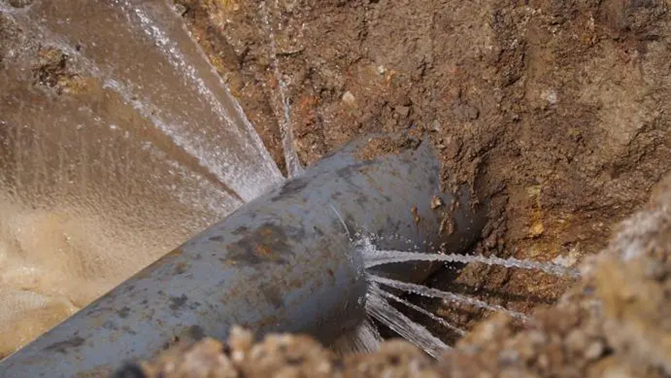The use of artificial intelligence has continued to grow exponentially. One of those uses includes leak detection and water infrastructure monitoring.
Water leakage is an issue plaguing structures of all shapes and sizes throughout the United States, amounting to over 2.5 trillion gallons of water lost each year. AI-powered leak detection systems are one of the latest advancements aimed at reducing that number significantly.

Like all uses of AI, it isn’t perfect. And like all new technologies, it may be best not to rely on it alone. Additional resources, like GPRS’ pinpoint leak detection services, can ensure the efficient location of leaks and lessen your non-revenue water loss.
If you are not utilizing an AI-powered leak detection system, the best alternative for monitoring your water infrastructure is routine water loss surveys performed by leak detection professionals, like GPRS Project Managers.
WHAT IS AI-POWERED LEAK DETECTION
AI-powered leak detection involves the use of smart sensors, like Internet of Things (IoT) sensors, and complex machine learning algorithms.
Since the early 2010s, facilities have used IoT sensors for leak detection. These sensors run 24/7 and wirelessly transmit data to a cloud-based system that can send alerts to its users.
Combined with a network of smart sensors, complex machine learning algorithms can identify signs of a leak. Acoustic data, flow patterns, and water pressure readings are some of the factors that contribute to the leak detection process. The algorithms can source a wide range of datasets from historical flow data, weather patterns, and geographic information systems (GIS) to ensure the data is compatible with the water infrastructure.
PROS AND CONS OF AI-POWERED LEAK DETECTION
One big advantage of AI leak detection systems is that they work proactively. They find issues before they become serious, rather than reacting to them later. Sensors and algorithms can help water utility and facility managers detect pressure losses before a small leak becomes a major one. However, no sensor can predict a leak, only report it once it occurs.
AI leak detection software can detect signs of a leak early because of the 24/7 monitoring. By predicting a leak with the use of historical data and real-time information, facilities can save time and money through regular, targeted maintenance.
Another advantage is their capability in complex systems. As long as the AI is trained properly, it can instantly locate the pipe segments that show signs of leakage, eliminating the need for guesswork.
Over time, the AI will also be able to adapt as it continues to collect data and learn about the system it is analyzing. Its accuracy and predictive capabilities will only get better as the system collects more information.
Despite the positives of implementing AI-powered leak detection software, there are other factors that must be considered.
Artificial intelligence is still an evolving technology. You should not view it as the only solution for leak detection and prevention. Over-reliance on AI without regular human oversight can lead to inadequate results.
AI can generate false or misleading information, commonly referred to as AI hallucinations. As reported by The New York Times, studies show that AI hallucinations seem to be getting worse as AI gets more advanced. When AI is used as a leak detector, hallucinations can lead to incorrect readings, like false positives or failure to detect a leak.
Also, the AI system is only as good as the data and algorithms used to train it. Like any new employee, you need to train the AI on how to work in your facility. AI training data includes sets of inputs and subsequent outputs that an AI uses to learn how to perform a task. If the AI-powered leak detection software is trained on data best suited for facilities with newer infrastructure, it will not present valuable information for an older building with infrastructure more at risk of leaks.
Additionally, if you choose to become heavily reliant on digital technologies like AI leak detection software in your water infrastructure, you must ensure the data is secure and not vulnerable to cyberattacks. Cybersecurity is a vital component of the design and installation of the AI system. Without it, your infrastructure and data are at risk.

Another factor to consider is the cost. Any kind of new, cutting-edge technology will come with a higher price tag than traditional methods. You don’t want to cut corners either, so it’s vital to have each of the following in mind when considering AI-powered leak detection systems for your facility:
- Installation and labor costs
- Training and expertise in AI software to train and maintain the AI
- Purchasing additional servers to securely store the data
- Hiring leak detection professionals
AI-powered leak detection is a complex system that, when combined with inspections by leak detection professionals like GPRS Project Managers, can pinpoint leaks in an efficient manner and prevent unnecessary water loss.
HOW TO COMBINE ACOUSTIC LEAK DETECTION SERVICES WITH AI-POWERED LEAK DETECTION SYSTEMS
As previously mentioned, AI-powered leak detection systems can identify leaks and the pipe segments from which water is leaking. However, they are unable to pinpoint the exact location of the leak in that pipe segment. That is where GPRS comes in.
SIM-certified GPRS Project Managers are experts in the most advanced leak detection equipment and have well-trained ears when listening for leaks in pressurized water systems or fire loops.

The equipment utilized by GPRS Project Managers when pinpointing leaks includes acoustic leak detectors, leak noise correlators, ground penetrating radar (GPR), and electromagnetic (EM) locators.
Acoustic leak detectors locate leaks with a sensitive ground microphone or an acoustic listening device. The device is either used at the surface level or dropped into a manhole. Acoustic leak detection equipment typically consists of a microphone, noise-cancelling headphones, and an electric monitor.

Leak noise correlators, also called leak detection correlators, use sensors placed on both sides of a pipe that send information back through radio waves. The processing unit compares the data with algorithms designed for certain noise profiles, which determine the exact location of any leaks.

GPRS Project Managers can use leak noise correlators and acoustic leak detectors in tandem to provide clients with the most accurate location of their leaking pipes. Acoustic leak detectors and leak noise correlators can also be used with utility locating equipment, like GPR and EM locators. By using them with leak detection technology, GPRS Project Managers can mark exactly where the leak is located on the ground and ensure that the leak can be fixed without striking other utilities.
All GPRS Project Managers are certified in Subsurface Investigation Methodology (SIM), where one of the main guidelines is the use of complementary technologies when performing a locate or investigation.
Upon the completion of an investigation, Project Managers will then upload all the scan data to SiteMap® (patent-pending), GPRS’ cloud-based infrastructure management platform. With SiteMap, all your underground utility data is securely stored in one place and is geospatially accurate to allow for enhanced analysis and collaboration capabilities.
By utilizing each piece of technology mentioned above with the data collected by AI-powered leak detection systems, facilities can work proactively rather than reactively to prevent costly leaks and enhance the stability of their bottom line.
What can we help you visualize?
FREQUENTLY ASKED QUESTIONS
How long does a leak detection usually take?
How long it takes to find your leak depends on the system size, complexity, and access conditions. A standard survey of a small facility or municipal segment may take several hours, while larger networks can require multiple days. GPRS optimizes efficiency through pre-survey planning and site walks, real-time data collection, and advanced equipment, minimizing disruption and ensuring timely reporting.
Why does leak detection usually occur early in the morning?
Our acoustic listening equipment is highly sensitive and amplifies leaks and other noises which mask leak signals during the day. In a city environment, the ambient noise – airplanes, traffic, mowers, machinery, and most importantly, people using water – can often mask the noise made by the leak. The GPRS Project Manager assigned to your job will determine if night work is necessary to minimize the amount of ambient noise.
Can you determine the size of a detected leak?
We determine the size of the leak by how far the leak signal travels between contact points and the pitch of the tone received. We do not, however, produce formal leak estimations.
What is an annual leak survey and why do they matter?
An annual leak survey is a scheduled inspection of water infrastructure to identify and document leaks. These surveys are critical for regulatory compliance, environmental protection, and cost control. Regular assessments reduce water loss, prevent hazardous conditions, and extend asset life. For municipalities and facilities, annual surveys support proactive maintenance and budget forecasting.



.svg)